Transporting a cat in a car can be a challenging and nerve-wracking experience. Cats are known for their aversion to car rides, making it essential to take extra precautions to ensure their safety and comfort. As a pet expert, I have gathered valuable tips and recommendations to help you navigate the often stressful process of traveling with your feline friend.
When it comes to car travel with cats, there are several important factors to consider. From choosing the right cat carrier to addressing cat car anxiety, each aspect plays a vital role in ensuring a smooth journey for both you and your furry companion. Together, let’s explore the best practices for transporting a cat safely and effectively.
Throughout this article, we will delve into various topics, including how to introduce your cat to car travel, selecting the right cat carrier, preparing the carrier for travel, managing anxiety and motion sickness, essential items to pack, planning stops and breaks, ensuring safety and emergency preparedness, training your cat for leash travel, microchipping and identification, and dealing with free-spirited cats during car travel.
Before we begin, let me emphasize that consulting with your veterinarian is crucial, as they can provide personalized advice based on your cat’s specific needs and medical history. Your veterinarian should always be your primary source of guidance throughout the journey.
Key Takeaways:
- Introduce your cat to short car rides to help them acclimate to the experience.
- Use a well-ventilated and appropriately sized cat carrier for their safety and comfort.
- Create a calming environment inside the carrier with familiar scents and comforting items.
- Prepare for potential anxiety or motion sickness with guidance from your veterinarian, including prescription medications if necessary.
- Pack essential items such as a first-aid kit, medications, food, water, and identification records.
Introducing Your Cat to Car Travel
Getting your cat accustomed to car travel can greatly reduce stress and anxiety during journeys. It’s important to start slowly and gradually familiarize your cat with the experience. Here are some tips for introducing your cat to car travel:
- Take your cat on short car rides: Start by taking your cat on a few short car rides to help them get used to the vehicle’s movement. Keep the rides brief at first and gradually increase the duration over time.
- Associate car trips with positive experiences: Make car trips a positive experience for your cat by providing treats, playtime, or cuddles after each ride. This will help your cat associate car travel with something enjoyable.
- Use your cat’s scent: Place a blanket or bedding with your cat’s scent inside the carrier. The familiar scent will provide comfort and help reduce stress during car travel.
By following these steps, you can help your cat feel more comfortable and relaxed during car travel. Remember to be patient and take things at your cat’s pace.
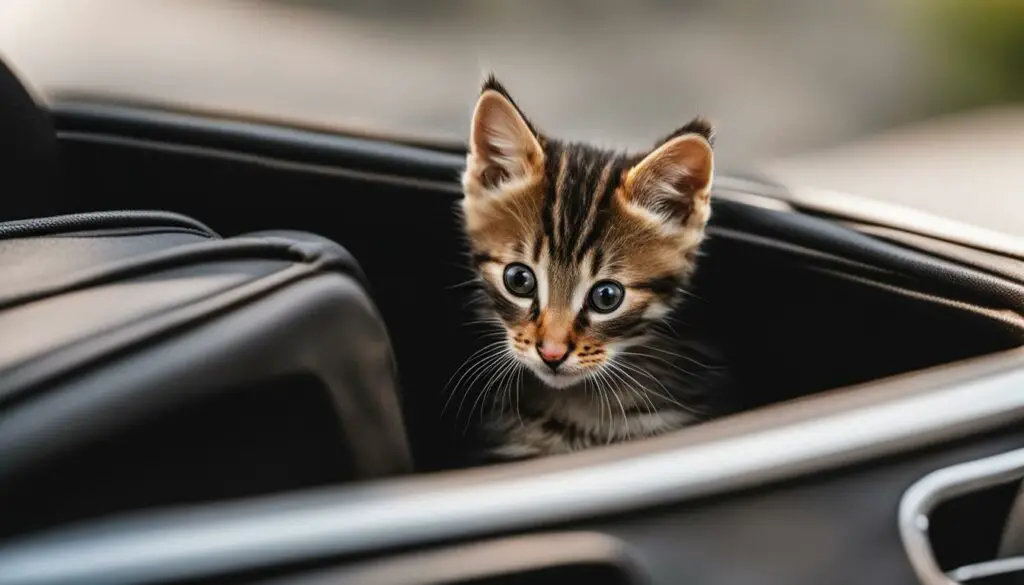
Table: Familiarizing Your Cat with Car Travel
| Steps | Description |
|---|---|
| 1. Short car rides | Start with short car rides and gradually increase duration |
| 2. Positive associations | Associate car trips with treats, playtime, or cuddles |
| 3. Use your cat’s scent | Place a blanket or bedding with your cat’s scent in the carrier |
Choosing the Right Cat Carrier for Car Travel
When it comes to transporting your cat in a car, selecting the right cat carrier is essential for their safety and comfort. A well-ventilated carrier provides the necessary airflow while keeping your furry friend secure during the journey. Here are some key factors to consider when choosing a cat carrier for car travel:
Size Matters
Ensure the carrier is spacious enough for your cat to stand, turn around, and lie down comfortably. Cats should have enough room to stretch and move, preventing feelings of confinement or discomfort during the journey.
Safety Features
Opt for a carrier with secure closures to prevent any accidental openings. Durable materials, such as hard plastic or sturdy fabric, will ensure the carrier withstands the rigors of travel. Additionally, carriers with added security features like latches or top-loading options offer extra peace of mind.
Extra Comfort
Consider carriers with additional features that can enhance your cat’s comfort. Detachable feeding bowls allow for easy access to food and water during the journey. Some carriers also come with soft bedding or blankets to provide a cozy and familiar environment for your cat.
By carefully choosing a cat carrier that meets these criteria, you can ensure a safe and stress-free travel experience for your feline companion.
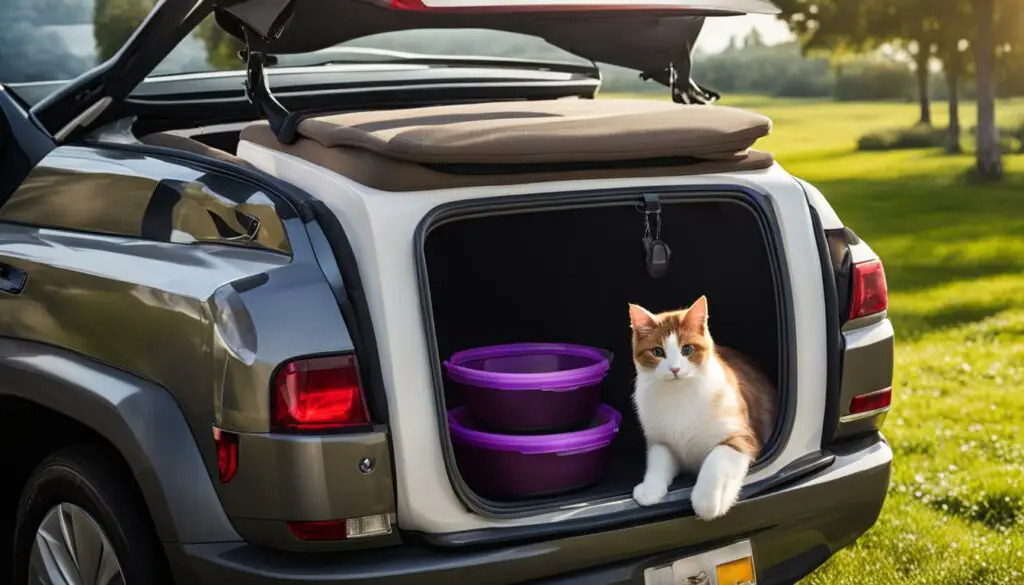
| Factors to Consider | Features |
|---|---|
| Size | Spacious enough for the cat to move comfortably |
| Safety | Secure closures, durable materials |
| Comfort | Additional features like detachable feeding bowls and soft bedding |
Preparing the Cat Carrier for Travel
Properly preparing the cat carrier for travel is essential to ensure your feline friend’s comfort and relaxation during the journey. By creating a calming and soothing environment within the carrier, you can help alleviate stress and anxiety. Here are a few tips to make the carrier comfortable for your cat:
- Add familiar scents: Place a blanket or bedding inside the carrier that smells like your cat. The familiar scent will provide a sense of security and comfort.
- Include favorite toys: Add a favorite toy or two in the carrier to provide familiarity and a source of entertainment. These toys can help keep your cat occupied and reduce boredom during the trip.
- Offer occasional treats: Give your cat occasional treats inside the carrier to create positive associations. This will help your cat view the carrier as a safe and rewarding space.
Remember to start preparing the carrier at least one month before the trip to give your cat sufficient time to acclimate to the carrier and feel at ease. A comfortable carrier will not only make car travel more pleasant for your cat but also contribute to a smoother and more enjoyable journey for both of you.
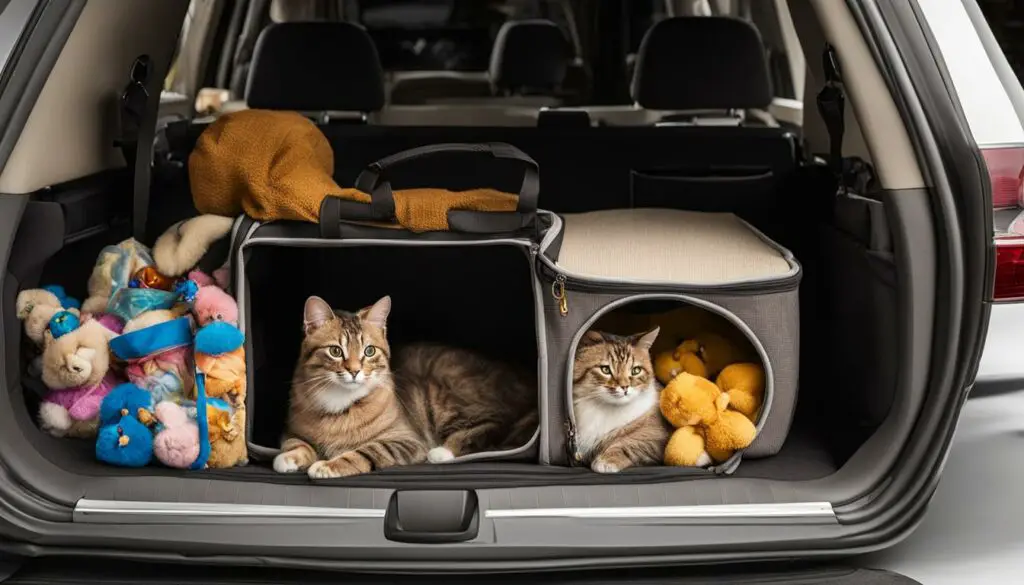
Testimonials:
“I followed these tips to prepare my cat’s carrier, and it made a world of difference! My cat seemed much calmer and more relaxed during our car trip. I highly recommend taking the time to make the carrier comfortable for your furry friend.” – Lisa S.
“I never realized how important it is to create a calming environment in the cat carrier until I tried these suggestions. My cat used to get anxious and restless during car travel, but now she seems more at ease. Thank you for these helpful tips!” – Michael T.
“Preparing the cat carrier has always been a challenge for me, but these simple strategies made a significant difference. My cat now willingly enters the carrier and even looks forward to car trips. I can’t thank you enough!” – Emily R.
By following these tips and making the carrier a comfortable and inviting space, you can help reduce your cat’s stress and anxiety during car travel. Remember to be patient and allow your cat time to adjust to the carrier before embarking on any long journeys. Happy travels!
Managing Anxiety and Motion Sickness in Cats
Traveling in a car can be stressful for cats, especially those prone to anxiety or motion sickness. As a responsible cat owner, it’s essential to address these issues to ensure a smooth and comfortable journey for your feline companion.
When it comes to treating cat anxiety in the car, consulting with your veterinarian is crucial. They can recommend prescription medications like trazodone or gabapentin that can help calm your cat during travel. It’s important to administer the medication a few hours before the trip to allow it to take effect and keep your cat stress-free.
Motion sickness is another common concern for cats during car travel. Watch out for signs such as excessive drooling or vomiting. If your cat experiences motion sickness, consult with your veterinarian for appropriate treatment options. They may suggest over-the-counter medications or prescribe medication to alleviate the symptoms.
| Symptoms of Cat Motion Sickness | Treatment Options |
|---|---|
| Excessive drooling | Over-the-counter motion sickness medications |
| Vomiting | Prescription medication from a veterinarian |
| Loss of appetite | Minimizing travel stress and using calming techniques |
Remember, every cat is unique, and it’s vital to consult with your veterinarian to determine the best course of action for managing anxiety and motion sickness in your specific feline friend.
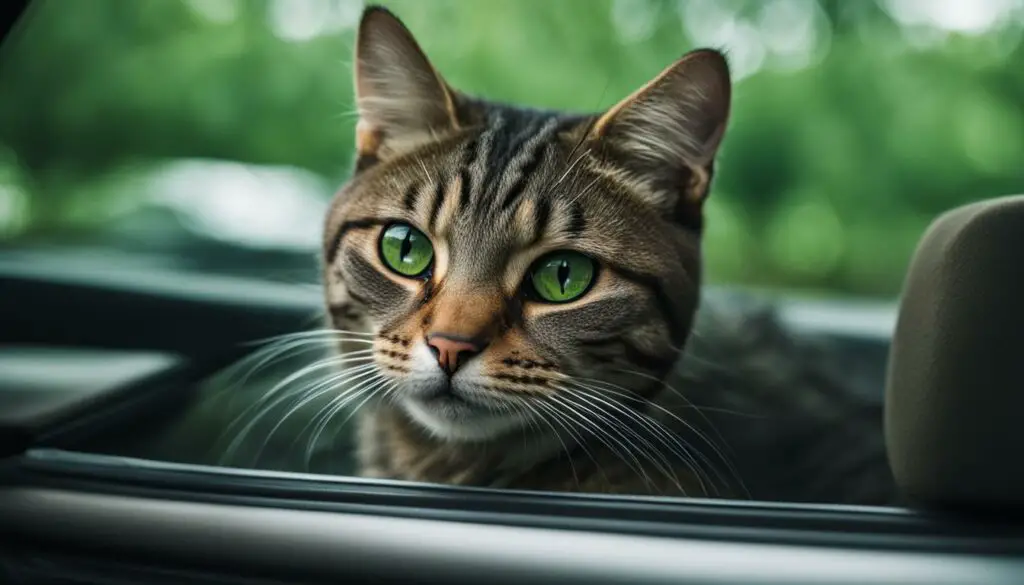
Tips for Managing Cat Anxiety and Motion Sickness
- Gradual Exposure: Familiarize your cat with car travel by taking short trips and gradually increasing the duration.
- Comfortable Carrier: Ensure your cat’s carrier is well-ventilated, secure, and offers a cozy space for their journey.
- Calming Techniques: Utilize pheromone sprays, calming music, or a familiar blanket to create a soothing environment.
- Positive Association: Associate car trips with positive experiences by offering treats, playtime, or rewards.
Essential Items to Pack for Cat Car Travel
When preparing for a car trip with your cat, it’s important to pack the essential items that will ensure their safety, comfort, and well-being throughout the journey. Here are the must-have items that should be included in your cat car travel checklist:
1. Cat First-Aid Kit
Just like humans, cats can experience accidents or health issues during travel. It’s crucial to have a cat first-aid kit on hand to address any minor injuries or ailments. Your first-aid kit should include items like gauze, adhesive tape, antiseptic solution, tweezers, and any prescribed medications your cat may need.
2. Cat Travel Documents
Before hitting the road, make sure you have all the necessary travel documents for your cat. This includes proof of vaccinations, health certificates, and any other documentation required by your destination or accommodation. Keeping these documents easily accessible will help ensure a smooth and hassle-free travel experience.
3. Food, Water, and Treats
Pack enough food, water, and treats to sustain your cat throughout the journey. Opt for travel-friendly portions and containers to make feeding and hydrating your cat easier on the road. Remember to bring their favorite treats as well, as they can be used to reward and comfort your cat during the trip.
4. Portable Litter Tray and Litter
Cats have specific bathroom needs, so it’s essential to include a portable litter tray and enough litter for the duration of the journey. Portable litter trays are convenient and can be easily cleaned and disposed of. Ensure your cat has a comfortable and familiar place to relieve themselves during rest stops.
5. Veterinary Records and Contact Information
Carrying copies of your cat’s veterinary records, including proof of vaccinations, is crucial during travel. In case of emergencies, it’s important to have your veterinarian’s contact information readily available. Additionally, storing the contact information for emergency veterinary services along your travel route can provide peace of mind.
By packing these essential items, you’ll be well-prepared to ensure a safe and comfortable journey for your cat during car travel.

Planning Stops and Breaks During Cat Car Travel
When embarking on a car journey with your cat, it’s essential to plan for regular stops to ensure their comfort and well-being. Just like humans, cats need bathroom breaks and the opportunity to stretch their legs during long journeys. Taking these breaks also gives you a chance to check on your cat and address any immediate needs they may have.
Research and reserve pet-friendly hotels or accommodations along your route to ensure a smooth travel experience. Not all hotels allow pets, so it’s crucial to plan ahead and find suitable options that welcome cats. By booking cat-friendly accommodations, you can provide your feline companion with a comfortable and safe environment during breaks and overnight stays.
Consider your cat’s needs and comfort when planning the duration between stops. Some cats may be more anxious or prone to motion sickness, requiring more frequent breaks. Others may be more relaxed and adaptable, allowing for longer stretches between stops. By understanding your cat’s individual needs, you can create a travel plan that prioritizes their well-being and minimizes stress.
In conclusion, planning stops and breaks during cat car travel is essential for the comfort and safety of your furry friend. By researching pet-friendly accommodations, allowing for bathroom breaks and stretch time, and considering your cat’s unique needs, you can ensure a smooth and enjoyable journey for both you and your cat.
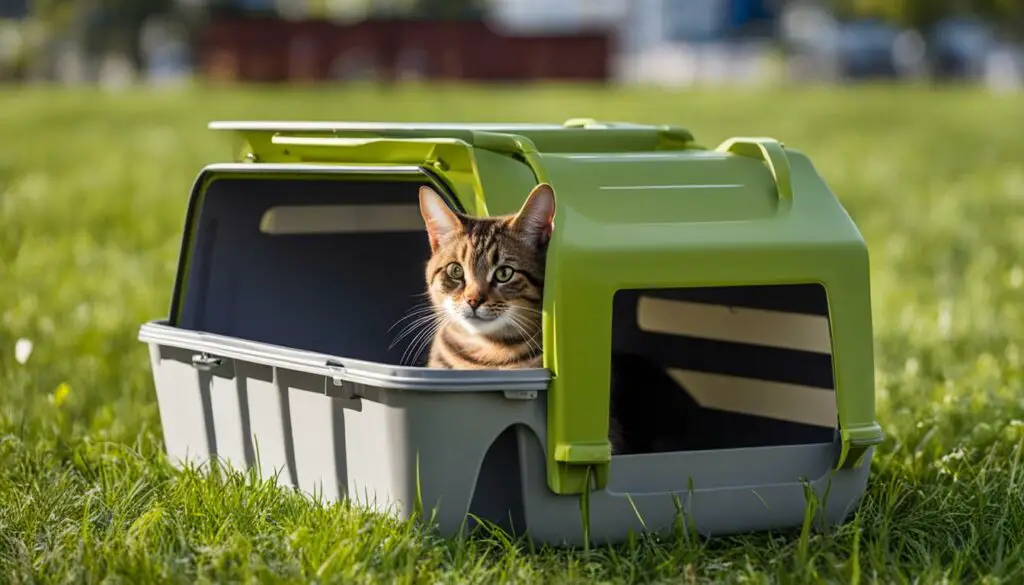
| Benefits of Planning Stops and Breaks During Cat Car Travel | Tips for Planning Stops and Breaks |
|---|---|
|
|
Safety and Emergency Preparedness During Cat Car Travel
When it comes to traveling with your cat in a car, ensuring their safety and being prepared for emergencies is of utmost importance. By taking a few simple steps, you can help make your cat’s car journey as safe and stress-free as possible.
Safety Measures
First and foremost, always have your veterinarian’s contact information readily available. In case of any emergencies or health concerns during your trip, you can quickly reach out for professional guidance.
Additionally, it’s essential to ensure that your cat has up-to-date identification. Microchipping is a reliable method of identification that can help reunite you with your cat if they were to get lost during travel. Remember to update the microchip registry with your current contact information.
Furthermore, consider investing in pet health insurance that covers your cat’s travel. Double-check if there are any coverage restrictions during travel and make sure you have all the necessary documentation and policy information with you.
Emergency Preparedness
Being prepared for emergencies is crucial. Along with having your veterinarian’s contact information, program the ASPCA Animal Poison Control Center number into your phone as well. This helpline can provide guidance if your cat ingests anything harmful or encounters other potential dangers.
It’s also wise to have a well-stocked first-aid kit specifically designed for cats. Include items such as bandages, wound cleaning solutions, and any necessary medications for your cat’s specific needs. Familiarize yourself with basic first-aid procedures beforehand to ensure you can administer immediate care if required.
Lastly, create a comprehensive emergency plan that addresses potential situations that may arise during your car journey. This may include knowing the location of emergency veterinary clinics along your route, having items such as a pet carrier and leash readily accessible, and having a plan for handling car breakdowns or other unforeseen circumstances.
By prioritizing your cat’s safety and being prepared for emergencies, you can enjoy a smoother and worry-free car travel experience with your feline companion.
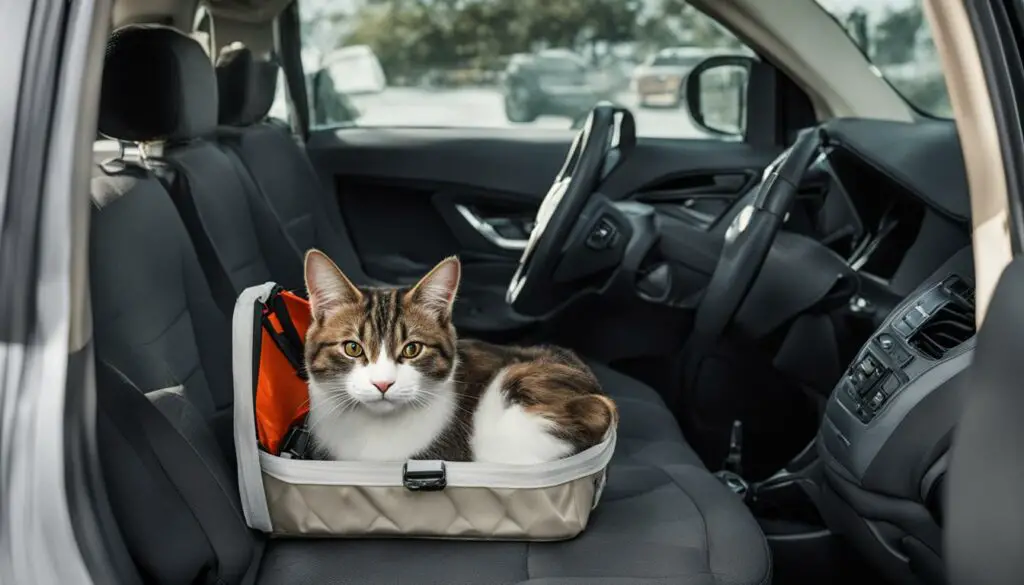
| Safety Tips for Cat Car Travel | |
|---|---|
| 1 | Keep your cat securely confined in a well-ventilated carrier during the car journey. |
| 2 | Ensure the carrier is the appropriate size for your cat, allowing them to stand, turn around, and lie down comfortably. |
| 3 | Pack a cat-friendly first-aid kit and have your veterinarian’s contact information readily available. |
| 4 | Take frequent breaks during long car rides to provide bathroom breaks and stretch your cat’s legs. |
| 5 | Plan for potential emergencies and have a well-thought-out emergency plan in place. |
Training Your Cat for Leash Travel
Leash training can be a beneficial skill to teach your cat, especially when it comes to car travel. Not only does it allow you to keep your cat safe and secure during stops and breaks, but it also gives them an opportunity to explore their surroundings in a controlled and supervised manner. Here are some tips to help you train your cat for leash travel:
Start Slow
Introduce the concept of a leash to your cat gradually. Begin by letting them wear a harness indoors for short periods, allowing them to get used to the sensation of having something on their body. Once they are comfortable with the harness, attach a leash and let them walk around the house while supervised. Reward them with treats and praise for positive behavior.
Positive Reinforcement
Use positive reinforcement techniques to encourage your cat to walk on a leash. Offer treats and praise as they take steps forward or explore their surroundings. Make the experience enjoyable for them, using toys or interactive play sessions during leash training. Be patient and consistent, allowing your cat to progress at their own pace.
Practice Outside
Once your cat is comfortable walking on a leash indoors, gradually transition to outdoor environments. Start in a quiet and familiar area, such as your backyard or a nearby park. Allow your cat to explore while keeping a close eye on them. Remember to use positive reinforcement and reward them for their progress. Over time, your cat will become more confident and comfortable with leash travel.
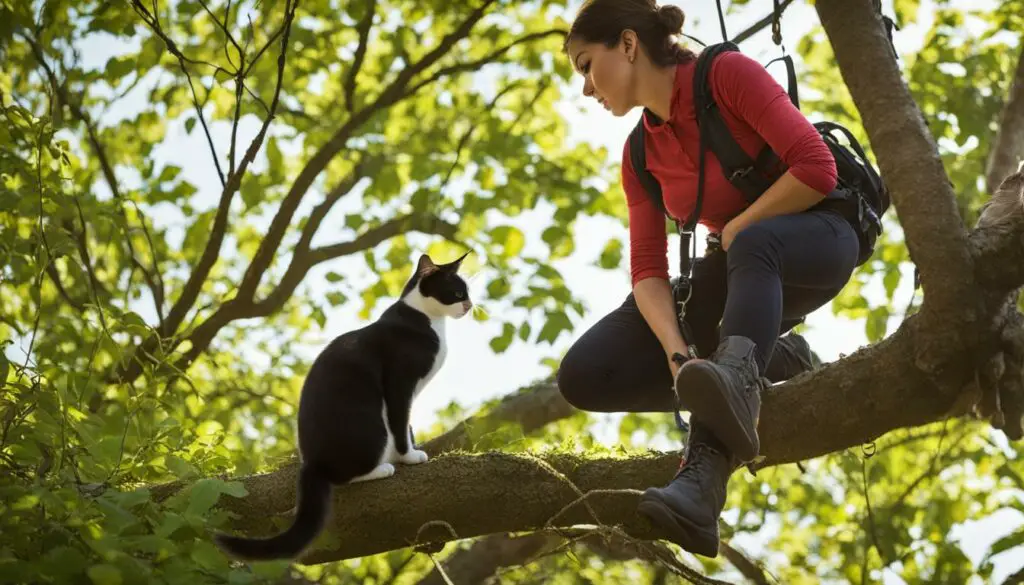
Leash training your cat for car travel can make the journey safer and more enjoyable for both you and your feline companion. Remember to be patient, use positive reinforcement, and gradually increase the complexity of the training. With time and practice, your cat will become a pro at leash walking, making car travel a breeze.
Microchipping and Identification for Cat Car Travel
When it comes to traveling with your beloved feline friend, ensuring their safety and security is of utmost importance. One crucial aspect of cat car travel is microchipping and proper identification. With the use of modern technology, microchipping has become a widely recognized method for reuniting lost pets with their owners. It involves inserting a tiny chip under your cat’s skin, which contains a unique identification number that can be scanned by a veterinarian or animal shelter. This identification number is linked to your contact information, ensuring that if your cat goes missing during travel, they have a higher chance of being returned to you.
In addition to microchipping, outfitting your cat with a collar that includes identification tags is another essential step in ensuring their safety during travel. The collar should have your name, phone number, and any other relevant contact information. This visible identification provides an immediate way for someone who finds your cat to contact you. Remember to update the information on both the microchip and identification tags if you change your contact details.
Tips for Cat Collar Identification
- Choose a collar that is comfortable and well-fitting for your cat. Make sure it is not too tight or too loose, allowing your cat to wear it comfortably during the journey.
- Use a breakaway collar. These collars are designed to break open if they get caught on something, reducing the risk of choking or injury to your cat.
- Consider adding reflective or glow-in-the-dark elements to the collar. This can increase visibility and make it easier to spot your cat, especially during nighttime travel.
- Regularly check the condition of the collar to ensure it remains intact and readable. If the collar becomes worn or the tags are no longer legible, replace them promptly.
By taking the necessary steps to microchip your cat and provide proper identification, you significantly increase the chances of a safe and happy journey for both you and your furry companion. Remember to keep all contact information up to date and ensure that your cat’s identification is visible and easy to read. This way, you can enjoy your cat car travel adventures with peace of mind, knowing that you have taken every precaution to keep your feline friend safe.
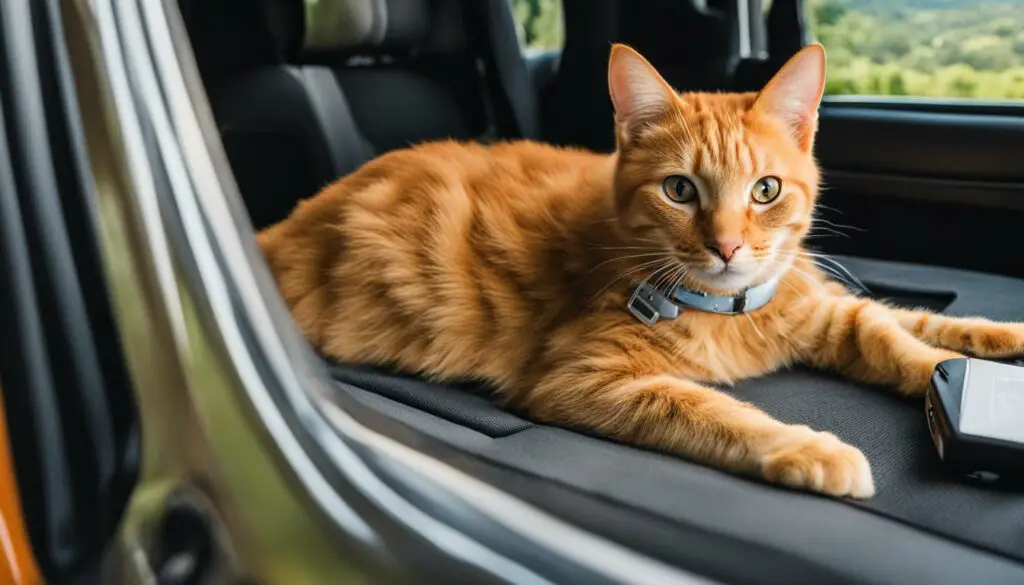
| Microchipping vs. Collar Identification | Microchipping | Collar Identification |
|---|---|---|
| Permanent identification method | ✔ | ✖ |
| Requires scanning by a veterinarian or animal shelter | ✔ | ✖ |
| Visible identification | ✖ | ✔ |
| Minimal risk of loss or removal | ✔ | ✖ |
| Can be updated with your latest contact information | ✔ | ✔ |
The Challenge of Traveling with a Free-Spirited Cat
Traveling with a free-spirited cat can be an adventure in itself. These independent felines often have a strong desire for exploration and may present unique challenges during car travel. However, with some careful planning and preparation, you can ensure a smoother journey for both you and your daring feline companion.
One key consideration when traveling with a free-spirited cat is to provide ample exercise and mental stimulation. These cats thrive on activity and may become restless or anxious during car rides. Before your trip, engage in interactive play sessions to tire out your cat and help release some of their pent-up energy. Consider packing their favorite toys or puzzle feeders to keep them occupied during the journey.
Another important aspect is to ensure your cat is properly secured in the car. Free-spirited cats may be more inclined to explore their surroundings and attempt daring escapes. Utilize a secure and well-ventilated carrier that is appropriate for your cat’s size. Additionally, consider using a harness or leash to provide extra security when taking breaks during the trip. Always monitor your cat closely to prevent any potential escapes or accidents.
Lastly, patience is key when traveling with a free-spirited cat. They may need time to adjust to the new environment and routine. Gradually introduce them to car rides and provide positive reinforcement to create positive associations. Remember to remain calm and patient throughout the journey, as your cat can sense your emotions.
Dealing with Independent Cats During Car Travel
Traveling with an independent cat requires adaptability and understanding. Here are some additional tips to help you navigate the challenges:
- Provide a familiar scent: Place a blanket or bedding with your cat’s scent in the carrier to provide comfort and familiarity.
- Keep a calm environment: Play soft classical music or use pheromone sprays to create a soothing atmosphere in the car.
- Consult with your veterinarian: If your cat experiences extreme anxiety during car travel, your veterinarian may recommend medications or natural remedies to help calm them.
Remember, each cat is unique, and it’s important to tailor your approach to their individual needs. By taking the time to understand and accommodate your free-spirited cat, you can make car travel a more enjoyable experience for both of you.
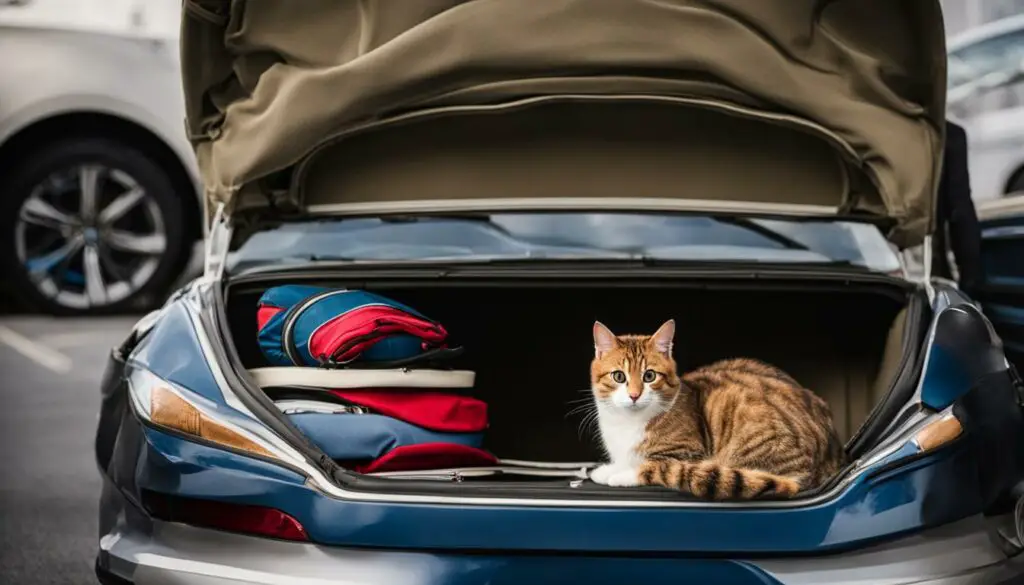
| Risks | Precautions |
|---|---|
| Escape attempts | Secure carrier and use a harness or leash |
| Restlessness and anxiety | Engage in interactive play and provide mental stimulation |
| Inadequate exercise | Plan for breaks and provide opportunities for exercise |
| Accidents or injury | Monitor your cat closely and ensure a safe car environment |
The Art of Cat Taxidermy – A Cautionary Tale
When it comes to showcasing our love for our feline companions, some individuals take it to extreme lengths. A recent incident involving an art teacher in Florida serves as a cautionary tale for those considering attempting the art of cat taxidermy. The results were, to say the least, unusual and alarming.
In an attempt to immortalize her beloved cat, the art teacher delved into the intricate process of taxidermy. However, the end result left much to be desired. The cat’s body appeared stretched and anatomically incorrect, leading many to question the artistic integrity of the project.
“The unconventional result of the taxidermy project gained widespread attention on social media. While opinions on the matter were divided, it sparked an interesting debate on the boundaries of art.”
Despite the unintended and unconventional outcome, the art teacher defended her intentions as pure artistry. While it is important to appreciate creativity and unique expression, this cautionary tale serves as a reminder that not all artistic ventures turn out as intended.
Table: Unintended Consequences of Cat Taxidermy
| Consequence | Description |
|---|---|
| Stretched Body | The taxidermy process resulted in a stretched and unnatural appearance of the cat’s body. |
| Anatomical Inaccuracy | The final result showcased anatomical inaccuracies, raising questions about the artistic integrity of the project. |
| Social Media Attention | The project gained significant attention on social media platforms, with mixed reactions from viewers. |
| Debate on Artistry | The unconventional result sparked a debate about the boundaries and definition of art. |
While the art of cat taxidermy may be tempting for some, it is crucial to consider the potential consequences and ensure that the well-being and integrity of the animal are prioritized. Art should evoke emotions and inspire, but it should also be respectful and mindful of the subjects it portrays.

Conclusion
Transporting a cat in a car can be a daunting task, but with the right preparations and strategies, it can become a smoother and more enjoyable experience for both you and your feline friend. By following these cat car travel tips, you can ensure a safe and comfortable journey for your furry companion.
First and foremost, invest in a suitable cat carrier that provides safety and security. Make the carrier a calming and familiar space by adding your cat’s scent, favorite toys, and occasional treats. Introduce your cat to car travel gradually, starting with short trips to help them become accustomed to the movement and the overall experience.
Additionally, consider your cat’s needs during the journey. Pack a well-equipped first-aid kit, along with enough food, water, and litter for the duration of the trip. Plan for regular breaks and research pet-friendly accommodations along your route. It’s crucial to have your veterinarian’s contact information and any necessary medications readily available in case of emergencies or unexpected situations.
Remember, patience is key when traveling with a cat. Each cat has its own unique personality and requirements, so consult with your veterinarian for personalized advice. By mastering the art of transporting a cat in a car, you can ensure a stress-free and enjoyable travel experience for both you and your beloved feline companion.
FAQ
Can I take my cat on a car trip?
Cats generally find traveling in a car stressful and confusing, but with proper preparations and training, it is possible to take your cat on a car trip.
How can I get my cat used to car travel?
Introduce your cat to short car rides gradually to help them get used to the experience. Start with short trips and gradually increase the duration.
What type of carrier should I use for my cat in the car?
Use a well-ventilated carrier that provides safety and security for your cat during the journey. Choose a carrier that is the appropriate size for your cat, allowing them to stand, turn around, and lie down comfortably.
How can I make the carrier a calming place for my cat?
Make the carrier a calming and soothing place for your cat at least one month before the trip. Place a blanket or bedding inside the carrier that smells like your cat and add a favorite toy or two for familiarity and comfort.
What should I pack for my cat’s car travel?
Pack a first-aid kit, medications, food, treats, water, and a litter tray for your cat. Bring copies of your cat’s veterinary records and contact information, as well as any necessary travel documents.
How often should I plan stops during a long car ride?
Plan regular stops to provide bathroom breaks and stretch your cat’s legs. Consider your cat’s needs and comfort when planning the duration between stops.
What should I do in case of emergencies during the journey?
Have your veterinarian’s contact information and the ASPCA Animal Poison Control Center number pre-programmed in your phone. Consider obtaining pet health insurance and check if any coverage restrictions apply during travel. Prepare for potential emergencies and have a plan in place to address them.
How can I train my cat for leash travel?
Consult with your veterinarian before attempting leash training. Start by training your cat to walk on a leash in a familiar environment and gradually introduce them to new situations, such as car travel.
How can I ensure my cat’s identification during travel?
Ensure your cat has up-to-date identification, such as a microchip and collar with your contact information. Provide updated information to the microchip registry and keep an updated collar tag.
What can I do if my cat is free-spirited and independent?
Traveling with a free-spirited cat can present unique challenges. Consider leash training and providing exercise opportunities along the way. Ensure your cat is properly secured and follow safety guidelines to prevent escapes.
What happened with the cat taxidermy project that gained attention on social media?
A Florida art teacher attempted feline taxidermy, resulting in a stretched and anatomically incorrect appearance of the cat’s body. The project gained attention and went viral on social media, with mixed reactions from viewers.
Is it possible to transport a cat in a car safely and comfortably?
Yes, by following the tips and guidelines outlined in this article, you can ensure a safer and more comfortable journey for your feline companion. Take the necessary precautions, prepare adequately, and consult with your veterinarian for specific recommendations based on your cat’s needs.








